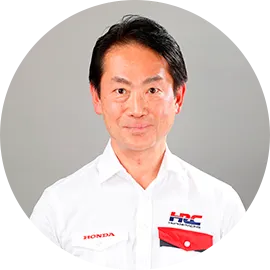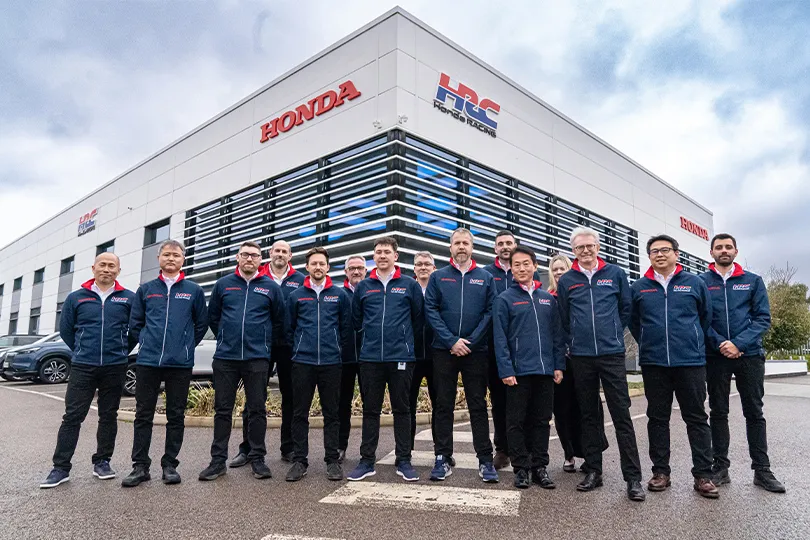POINTWhat you can learn from this article
- 2025 marks the 60th anniversary of Honda’s first F1 victory and the final year of its F1 partnership with Red Bull
- Honda continues its challenge in F1 to develop engineers at the world’s pinnacle of motorsports competing in cutting-edge hardware and software technology
- F1 popularity is continuing to rise worldwide, and operations have become more complex with the increased number of races. HRC is strengthening its global operation.
2025 marks the 60th anniversary of Honda’s first F1 victory in the 1965 Mexican Grand Prix. In this issue of Honda Stories, Koji Watanabe, President of Honda Racing Corporation (HRC), a racing arm Honda, share thoughts on Honda’s passion for F1, the significance of F1 participation, and Honda’s expectation for this season.

President and Representative Director of HRC View More Close Koji Watanabe
Watanabe joined Honda in 1987, and after serving as general manager of the European automobile business, he was appointed general manager of the Brand and Communication Division in April 2020. Assumed current role in 2022 to present.
CloseF1 as a “laboratory on wheels,” the world's pinnacle stage for developing engineers
2025 is the 60th anniversary of Honda’s first F1 victory.
 Koji Watanabe, HRC President
Koji Watanabe, HRC President
 Richie Ginther, driving the RA272, led Honda to its first F1 victory in the 1965 Mexican Grand Prix.
Richie Ginther, driving the RA272, led Honda to its first F1 victory in the 1965 Mexican Grand Prix.
60 years have passed since Honda’s first F1 victory, and during that time F1 cars have evolved in many ways, both in terms of hardware and software. What in particular has evolved?

The engines that power F1 cars have incorporated hybrid technology and are now referred to as “power units.” In Honda’s case, from naturally aspirated engines in 2008, the final year of Honda’s third F1 era to 2016, hybrid technology has increased maximum output by more than 200 horsepower, while reducing fuel consumption by one-third.
The same applies to software. Thanks to evolution in digital technology, hundreds of sensors attached to F1 cars are instantly shared with HRC Sakura (Honda’s F1 power unit development center) even if they are on the other side of the world, and data parameters have increased from 3,000 to over 20,000 in comparison to the third F1 era. We could not win without analyzing this data and understanding what is happening in the power unit to bring out its best performance.
For example, during practice sessions, data will be quickly and automatically analyzed while car is running on track, and the best settings are selected from thousands of options, and applied to the car as soon as the car is back in the pits. During the race, energy management of the power unit is adjusted in real time, with detailed changes being made to when and how much energy is released and recharged. Of course, HRC also develops this software in-house, making F1 racing the world’s best and most advanced technology competition in terms of both hardware and software.
 Power Unit test bench where hardware is developed.
Power Unit test bench where hardware is developed.
 HRC Sakura Mission Room connected to race tracks around the world in real time.
HRC Sakura Mission Room connected to race tracks around the world in real time.
What is significance of Honda continuing its challenge in F1?

F1 races are held every two weeks, sometimes every week. Within this limited time frame, the cars must build up one horsepower at a time and compete for every one-thousandth of a second with ultra-high speed and precision. In such an extreme environment, Honda engineers, gathered from inside and outside the company and driven by the common goal of being the world’s best, continue to challenge themselves every day. The unique experience of challenging the world of F1 trains Honda engineers. As F1 is state-of-the-art, it is not possible to apply F1 technology directly to products. However, some engineers with F1 experience are developing the e:HEV hybrid technology for mass-production vehicles, some are involved in the development of the eVTOL next-generation mobility system, providing the driving force to create something the world has not seen yet. I believe that HRC can help develop technologies for the future that are still considered impossible now. F1 continues to be a “laboratory on wheels,” ever-changing through the ages.
The significance of Honda’s F1 challenge remains the same today. It is the development of engineers by competing in the world’s pinnacle motorsports category.
F1 popularity rises and number of races increases: HRC strengthens global operation in response
In 2025, F1 races will be held from March to December all around the world. Twenty-four races are scheduled. Why has F1 become increasingly popular in North America in recent years?

Considering that in Honda’s third F1 era starting in 2008, where there were around 17 races per year, we can see how the number of races has increased. This is especially true in North America, where in addition to the three races in the US, five races are held in North America with Canada and Mexico included.
The increase in races in North America was triggered by the acquisition of the Formula One Group by US-based Liberty Media in 2016, and the surge of young F1 fans in North America, which was triggered by the F1 documentary program “Drive to Survive” produced by Netflix.
North America is an important market for Honda, and we believe that F1 activities can make a significant contribution to improving Honda’s brand.
What specific changes have you made to the global operation of HRC bases to address the increase in the number of races?

HRC currently has bases in Japan, the US, and the UK and has established a global management structure. First, in 2022, we reorganized our US automobile racing development company, Honda Performance Development, known as HPD to strengthen its structure and changed its name to Honda Racing Corporation USA (HRC US).
Last year, we established Honda Racing Corporation UK (HRC UK) in Milton Keynes, U.K. With one-third of the 24 rounds held in Europe, we decided that having a base in Europe was the best way to make the complex operations of current F1 development run more smoothly and to increase competitiveness. HRC UK has already established a team of engineers, mechanics, and public relations staff, who are now working from this base.
 HRC UK has begun its activities
HRC UK has begun its activities
Honda determined to complete final year with Red Bull on a high note
 At the 2024 Las Vegas Grand Prix (Ⓒ Red Bull Content Pool)
At the 2024 Las Vegas Grand Prix (Ⓒ Red Bull Content Pool)
The collaboration with Red Bull, that began in 2018 with the supplying of power units to the Scuderia Toro Rosso team (now VCARB: Visa Cash App Racing Bulls,) will enter its eighth and final year in 2025. In addition, it has been decided that Yuki Tsunoda will race in the Japanese GP for Oracle Red Bull Racing. What do you look forward to in this season?

Looking back, we won our first race in Honda’s fourth F1 era at the 2019 Austrian Grand Prix, finished 1-2 in the Brazilian Grand Prix, Scuderia AlphaTauri (now VCARB) won at the 2020 Italian GP in Monza, and won 21 races out of 22 in 2023, the highest winning percentage in F1 history. All with the Red Bull.
It was also power units built upon Honda technology that helped Max Verstappen win his first Formula 1 world championship with the Red Bull Racing Honda team in 2021, followed by three more consecutive titles. We are proud to say that this partnership has been a great success in the history of F1.
In addition, this week’s Japanese Grand Prix will be the first time that a graduate from Honda’s driver development program, Yuki Tsunoda, will race for Red Bull Racing. We are very happy that a Japanese driver will be racing for a top team, and we have high expectations for Tsunoda, who has matured well in his fifth year as an F1 driver.
In 2025, the final year of our partnership, we will continue to do our best with the Red Bull and VCARB teams to achieve championship victory to end on a high note. We look forward to your continued support.
Thank you very much.
Index







Honda began selling cars in 1963 and entered F1 the following year. Some may think that it is reckless to take on the challenge of racing in F1, the pinnacle of motorsports, only after two years into selling cars, but the following year, in 1965, Honda won its first F1 grand prix in Mexico with the RA272. Honda boldly took on the challenge of setting high goals and achieving results. This F1 participation and first victory were symbols of Honda’s corporate culture, and the challenging spirit remains unchanged to this day.